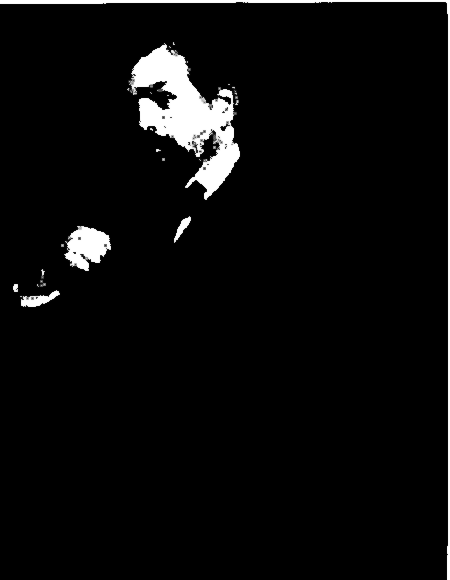
Project Gutenberg's Debussy's Pelléas et Mélisande, by Lawrence Gilman
This eBook is for the use of anyone anywhere at no cost and with
almost no restrictions whatsoever. You may copy it, give it away or
re-use it under the terms of the Project Gutenberg License included
with this eBook or online at www.gutenberg.org
Title: Debussy's Pelléas et Mélisande
A Guide to the Opera with Musical Examples from the Score
Author: Lawrence Gilman
Release Date: August 8, 2005 [EBook #16488]
Language: English
Character set encoding: ISO-8859-1
*** START OF THIS PROJECT GUTENBERG EBOOK DEBUSSY'S PELLÉAS ET MÉLISANDE ***
Produced by David Newman, Chuck Greif and the Online
Distributed Proofreading Team at https://www.pgdp.net

AUTHOR OF "PHASES OF MODERN MUSIC," "THE MUSIC OF TO-MORROW," "STORIES OF SYMPHONIC MUSIC," "EDWARD MACDOWELL" (IN "LIVING MASTERS OF MUSIC" SERIES) "STRAUSS' 'SALOME,'" ETC.

"It is not an ill thing to cross at times the marches of silence and see the phantoms of life and death in a new way. It is not an ill thing, even if one meet only the fantasies of beauty."—FIONA MACLEOD.
With the production at Paris in the spring of 1902 of Claude Debussy's Pelléas et Mélisande, based on the play of Maeterlinck, the history of music turned a new and surprising page. "It is necessary," declared an acute French critic, M. Jean Marnold, writing shortly after the event, "to go back perhaps to Tristan to find in the opera house an event so important in certain respects for the evolution of musical art." The assertion strikes one to-day, five years after, as, if anything, over-cautious. Pelléas et Mélisande exhibited not simply a new manner of writing opera, but a new kind of music—a new way of evolving and combining tones, a new order of harmonic, melodic and rhythmic structure. The style of it was absolutely new and absolutely distinctive: the thing had never been done before, save, in a lesser degree, by Debussy himself in his then little known earlier work. Prior to the appearance of Pelléas et Mélisande, he had put forth, without appreciably disturbing the musical waters, all of the extraordinary and individual music with which his fame is now associated, except the three orchestral "sketches," La Mer (composed in 1903-1905 and published in the latter year), the piano pieces Estampes (1903), and Images, Masques, l'Île joyeuse (1905), and a few songs. Certain audiences in Paris had heard, nine years before, his setting of Rossetti's "Blessed Damozel" (La Demoiselle Élue), a "lyric poem" for two solo voices, female chorus, and orchestra; in the same year (1893) his string quartet was played by Ysaÿe and his associates; in 1894 his Prélude à l'Après-midi d'un Faune was produced at a concert of the National Society of Music; the first two Nocturnes for orchestra, Nuages and Fêtes, were played at a Lamoureux concert in 1900; the third, Sirènes, was performed with the others in the following year. Yet it was not until Pelléas et Mélisande was produced at the Opéra-Comique in April, 1902, that his work began seriously to be reckoned with outside of the small and inquisitive public, in Paris and elsewhere, that had known and valued—or execrated—it.
In this score Debussy went far beyond the point to which his methods had previously led him. It was, for all who heard it or came to know it, a revelation of the possibilities of tonal effect—this dim and wavering and elusive music, with its infinitely subtle gradations, its gossamer fineness of texture, its delicate sonorities, its strange and echoing dissonances, its singular richness of mood, its shadowy beauty, its exquisite and elaborate art—this music which drifted before the senses like iridescent vapor, suffused with rich lights, pervasive, imponderable, evanescent. It was music at once naïve and complex, innocent and impassioned, fragile and sonorous. It spoke with an accent unmistakably grave and sincere; yet it spoke without emphasis: indirectly, flexibly, with fluid and unpredictable expression. It was eloquent beyond denial, yet its reticence, its economy of gesture, were extreme—were, indeed, the very negation of emphasis. Is it strange that such music—hesitant, evasive, dream-filled, strangely ecstatic, with its wistful and twilight loveliness, its blended subtlety and simplicity—should have been as difficult to trace to any definite source as it was, for the general, immensely astonishing and unexpected? There was nothing like it to be found in Wagner, or in his more conspicuous and triumphant successors—in, so to speak, the direct and royal line. Richard Strauss was, clearly, not writing in that manner; nor were the brother musicians of Debussy in his own France; nor, quite as obviously, were the Russians. The immediate effect of its strangeness and newness was, of course, to direct the attention of the larger world of music, within Paris and without, to the artistic personality and the previous attainments of the man who had surprisingly put forth such incommensurable music.
Achille[1] Claude Debussy was born at St. Germain-en-Laye (Seine-et-Oise), France, August 22, 1862. He was still a youth when he entered the Paris Conservatory, where he studied harmony under Lavignac, composition under Guiraud, and piano playing with Marmontel. He was only fourteen when he won the first medal for solfège, and fifteen when he won the second pianoforte prize.
In 1884, when he was in his twenty-second year, his cantata, l'Enfant prodigue, won for him the Prix de Rome by a majority of twenty-two out of twenty-eight votes—it is said to have been the unanimous opinion of the jury that the score was "one of the most interesting that had been heard at the Institut for years." While at the Villa Médicis he composed, in 1887, his Printemps for chorus and orchestra, and, in the following year, his setting of Rossetti's "Blessed Damozel," of which the authorities at the Conservatory saw fit to disapprove because of certain liberties which Debussy even then was taking with established and revered traditions. He performed his military service upon his return from Rome; and there is a tradition told, as bearing upon his love of recondite sonorities, to the effect that while at Évreux he delighted in the harmonic clash caused by the simultaneous sounding of the trumpet call for the extinguishing of lights and the sustained vibrations of some neighboring convent bells. From this time forward his output was persistent and moderately copious. To the year 1888 belong, in addition to La Demoiselle Élue, the remarkably individual "Ariettes,"[2] six settings for voice and piano of poems by Verlaine. To 1889-1890 belong the Fantaisie for piano and orchestra and the striking "Cinq Poèmes de Baudelaire" (Le Balcon, Harmonie du Soir, Le Jet d'Eau, Recueillement, La Mort des Amants). In 1891 came some less significant piano pieces; but the following two years were richly productive, for they brought forth the exquisite Prélude à l'Après-midi d'un Faune for orchestra, after the Éclogue of Mallarmé—the first extended and inescapable manifestation of Debussy's singular gifts—and the very personal but less important string quartet. In 1893-1895 he was busied with Pelléas et Mélisande,[3] and with the Proseslyriques, four songs—not of his best—to words of his own (De Rêve, De Grève, De Fleurs, De Soir). The next four years—1896-1899—saw the issue of the extremely characteristic and uncompromising Nocturnes for orchestra (Nuages, Fêtes, Sirènes), and the fascinating and subtle Chansons de Bilitis, after Pierre Louys—songs in which, aptly observed his colleague Bruneau, "he mingled an antique and almost evaporated perfume with penetrating modern odors." The collection "Pour le Piano" (Prélude, Sarabande, Toccata)—inventions of distinguished and original style—and some less representative songs and piano pieces, completed his achievements before the production of Pelléas et Mélisande brought him fame and a measure of relief from lean and pinching days. He has from time to time made public appearances in Paris as a pianist in concerts of chamber music; and he has even resorted—one wonders how desperately?—to the writing of music criticism for various journals and reviews. "Artists," he has somewhat cynically observed, "struggle long enough to win their place in the market; once the sale of their productions is assured, they quickly go backward." There is as yet no sign that he himself is fulfilling this prediction; for his most recent published performance,[4] the superbly fantastic and imaginative La Mer—completed three years after the production of Pelléas—is charged to the brim with his peculiar and potent quality.
What are the more prominent traits of the music of this man who is the product of no school, who has no essential affinities with his contemporaries, who has been accurately characterized as the "très exceptionnel, très curieux, très solitaire M. Claude Debussy"? One is struck, first of all, in savoring his art, by its extreme fluidity, its vagueness of contour, its lack of obvious and definite outline. It is cloudlike, evanescent, impalpable; it passes before the aural vision (so to speak) like a floating and multicolored mist; it is shifting, fugitive, intangible, atmospheric. Its beauty is not the beauty that issues from clear and transparent designs, from a lucid and outspoken style: it is a remote and inexplicable beauty, a beauty shot through with mystery and strangeness, baffling, incalculable. It is unexpected and subtle in accent, wayward and fantastic in rhythm. Harmonically it obeys no known law—consonances, dissonances, are interfused, blended, re-echoed, juxtaposed, without the smallest regard for the rules of tonal relationship established by long tradition. It recognizes no boundaries whatsoever between the different keys; there is constant flux and change, and the same tonality is seldom maintained beyond a single beat of the measure. There are key-signatures, but they strike one as having been put in place as a mere yielding to what M. Debussy doubtless regards indulgently as an amiable and harmless prejudice. His melodic schemes suggest no known model—they conform to patterns which intertwine and melt and are suddenly and surprisingly transformed; they are without punctuation, uncadenced, irregular, unpredictable, indescribably sensitive and supple. There is a marked indifference to the possibilities of contrapuntal effect, a dependence upon a method fundamentally homophonic rather than polyphonic—this music is a rich and shimmering texture of blended chord-groups, rather than a pattern of interlaced melodic strands. One cannot but note the manner in which it abhors and shuns the easily achieved, the facile, the expected. Its colors and designs are rare and far-sought and most heedfully contrived; its eloquence is never unrestrained; and this hatred of the obvious is as plainly sincere as it is passionate and uncompromising; it is not the fastidiousness of a précieux, but of an extravagantly scrupulous and austerely exacting artist.
Here, then, is as anomalous an aesthetic product as one could well imagine. In a day when magnitude of plan and vividness of color, rhetorical emphasis and dynamic brilliancy, are the ideals which preëminently sway our tonal architects, emerges this reticent, half-lit, delicately structured, subtly accented music; which is incorrigibly unrhetorical; which never declaims or insists: an art alembicated, static, severely restrained—for even when it is most harmonically untrammeled, most rhythmically fantastic, one is aware of a quietly inexorable logic, an uncompromising ideal of form, underlying its seemingly unregulated processes. It is the product of a temperament unique in music, though familiar enough in the modern expression of the other arts. Debussy is of that clan who have uncompromisingly "turned their longing after the wind and wave of the mind." He is, as I have elsewhere written, of the order of those poets and dreamers who persistently heed, and seek to continue in their art, not the echoes of passional and adventurous experience, but the vibrations of the spirit beneath. He is of the brotherhood of those mystical explorers, of peculiarly modern temper, who are perhaps most essentially represented in the plays and poetry and philosophies of Mr. Yeats and M. Maeterlinck: those who dwell—it has before been said—"upon the confines of a crepuscular world whose every phase is full of subtle portent, and who are convinced (in the phrase of M. Maeterlinck himself) 'that there are in man many regions more fertile, more profound, and more interesting than those of his reason or his intelligence.'" It is an order of temperament for which the things of the marginal world of the mind are of transcendent consequence—that world which is perpetually haunted, for those mystics who are also the slaves of beauty, by remote illusions and disquieting enchantments: where it is not dreams, but the reflections of dreams, that obsess; where passion is less the desire of life than of the shadow of life. It is a world of images and refractions, of visions and presentiments, a world which swims in dim and opalescent mists—where gestures are adored and every footfall is charged with indescribable intimations; where, "even in the swaying of a hand or the dropping of unbound hair, there is less suggestion of individual action than of a divinity living within, shaping an elaborate beauty in a dream for its own delight." It is, for those who inhabit it, a world as exclusively preoccupying and authentic as it is, for those who do not, incredible and inaccessible. The reports of it, intense and gleaming as they may be, which are contained in the art of such of its inhabitants as Debussy, are, admittedly, little likely to conciliate the unbeliever. This is music which it is hopeless to attempt to justify or promote. It persuades, or it does not; one is attuned to it, or one is not. For those who do savor and value it, it is reasonable only to attempt some such notation of its qualities as is offered here.
Debussy's ancestry is not easily traced. Wagner, whom he has amused himself by decrying in the course of his critical excursions, shaped certain aspects of his style. In some of the early songs one realizes quite clearly his indebtedness to the score of Tristan; yet in these very songs—say the Harmonie du Soir and La Mort des Amants (composed in 1889-1890)—there are amazingly individual pages: pages which even to-day sound ultra-modern. And when one recalls that at the time these songs were written the score of Parsifal had been off Wagner's desk for only seven years, that Richard Strauss was putting forth such tentative things as his Don Juan and Tod und Verklärung, that the "revolutionary" Max Reger was a boy of sixteen, and that Debussy himself was not yet thirty, one is in a position forcibly to realize the early growth and the genuineness of his independence. Adolphe Jullien, the veteran French critic, discerns in his earlier writing the influence of such Russians as Borodine, Rimsky-Korsakoff, and Mussorgsky—a discovery which one finds some difficulty in crediting. Later, Debussy was undoubtedly affected, in a slight degree, by César Franck; and there were moments—happily infrequent—during what one may call his middle period, when a whiff of the perfumed sentiment of Massenet blew disturbingly across his usually sincere and poetic pages. But for traces of Liszt, or Berlioz, or Brahms, one will search fruitlessly. That he does not, to-day, touch hands at any point with his brother musicians of the elder school in France—with such, for example, as the excellent and brilliant and superbly unimaginative Saint-Saëns—goes almost without saying. With Vincent d'Indy, a musician of wholly antipodal qualities, he disputes the place of honor among the elect of the "younger" school (whose members are not so young as they are painted); and he is the worshiped idol of still younger Frenchmen who envy, depreciate, and industriously imitate his fascinating and dangerously luring art. He has traveled far on the path of his particular destiny; not since Wagner has any modern music-maker perfected a style so saturated with personality—there are far fewer derivations in his art than in the art of Strauss, through whose scores pace the ghosts of certain of the greater dead. All that Wagner could teach him of the potency of dissonance, of structural freedom and elasticity, of harmonic daring, Debussy eagerly learned and applied, as a foundation, to his own intricately reasoned though spontaneous art; yet Wagner would have gasped alike at the novelty and the exquisite art of Pelléas et Mélisande, of the Nocturnes, even of the comparatively early Prélude à l'Après-midi d'un Faune; for this is music of a kind which may, indeed, have been dreamed of, but which certainly had never found its way upon paper, before Debussy quietly recorded it in his scores.
What is the secret principle of his method?—if one can call that a "method" which is, in effect, nothing if not airily unmethodical, and that principle "secret" which is neither recondite nor perplexing. It is simply that Debussy, instead of depending upon the strictly limited major and minor modes of the modern scale system, employs almost continuously, as the structural basis of his music, the mediaeval church modes, with their far greater latitude, freedom, and variety. It is, to say the least, a novel procedure. Other modern composers before Debussy had, of course, utilized the characteristic plain-song progressions to secure, for special purposes, a particular and definite effect of color; but no one had ever before deliberately adopted the Gregorian chant as a substitute for the modern major and minor scales, with their deep-rooted and ineradicable harmonic tendencies, their perpetual suggestion of traditional cadences and resolutions. To forget the principles underlying three centuries of harmonic practice and revert to the methods of the mediaeval church composers, required an extraordinary degree of imaginative intuition; purposely and consistently to employ those methods as a foundation upon which to erect an harmonic structure most richly and elastically contrived—to vitalize the antique modes with the accumulated product of modern divination and accomplishment—was little less than an inspiration. Debussy must undoubtedly have realized that the familiar scales, which have so long and so faithfully served the expressional needs of the modern composer, tend now to give issue to musical forms that are beginning to seem clichée: forms too rigidly patterned, too redolent of outworn formulas—in short, too completely crystallized. Chopin, Liszt, Wagner, and after them the modern Germans and their followers, found in a scale of semitones a limited avenue of escape from the confinement of the modern diatonic modes, and bequeathed to contemporary music an inheritance of ungoverned chromaticism which still clogs its progress and obstructs its independence. Debussy, through his appreciation of the living value of the old church modes, has been enabled to shape for himself a manner of utterance which derives from none of these influences. It is anything but chromatic; indeed, one of its most striking characteristics is its use of whole-tone progressions, a natural result, of course, of its dependence upon the old modes. Other contemporary Frenchmen have made occasional use of Gregorian effects; but Debussy was the first to adopt them deliberately as the basis of a settled manner of utterance, and he has employed them with increasing consistency and devotion. His example has indubitably served to enrich the expressional material at the disposal of the modern music-maker—there cannot conceivably, in reason, be two opinions as to that: he has acted upon a principle which is, beyond question, liberating and stimulating. And the adaptability to his own peculiar temperament of the wavering and fluid order of discourse which is permitted by the flexibility and variety of the antique modes is sufficiently obvious.
His resort to Gregorian principles is, it has been observed, far from being a matter of recent history with him. Almost twenty years ago we find him writing in the spirit of the old modes. Examine the opening phrases of his song, Harmonie du Soir (composed in 1889-1890), and note the felicitous adaptation to modern use of the "authentic" mode known as the Lydian, which corresponds to a C-major scale with F-sharp. Observe the use of the same mode in the introductory measures, and elsewhere, of his setting of Verlaine's Il pleure dans mon coeur (1889), the second of the "Ariettes." Five years later, in Pelléas et Mélisande, the trait is omnipresent—too extensive and obvious, indeed, to require detailed indication. One might point out, at random, the derivation from the seventh of the ecclesiastical modes (the Mixolydian) of the phrase in the accompaniment to Arkël's words in the final scene, "L'âme humaine aime à s'en aller seule;" or the relationship between the opening measures of the orchestral introduction to the drama and the first of the "authentic" modes, the Dorian; or between the same mode (corresponding to the D-minor scale without accidentals) and Mélisande's song at the tower window at the beginning of the third act.
It remains only to be said, by way of conclusion to this brief survey, that, for those who are disposed to open their sensibilities to the appeal of this music, its high and haunting beauty must exert an increasing sway over the heart and the imagination. It is making no excessive or invidious claim for it to assert that, after one has truly savored its quality, other music, transcendent though it may demonstrably be, seems a little coarse-fibred, a little otiose, a little—as Jules Laforgue might have said—quotidienne. But, however it may come to be ranked, there are few, I think, who will not recognize here an accent that is personal and unique, a peculiar ecstasy, a pervading and influential magic.
Maurice Maeterlinck's Pelléas et Mélisande, published in 1892, stands fifth in the chronological order of his dramatic works. It was preceded by La Princesse Maleine (1889); L'Intruse, Les Aveugles (1890); and Les sept Princesses (1891). Since its appearance Maeterlinck has published these plays: Alladine et Palomides; Intérieur; La Mort de Tintagiles: Trois petits drames pour Marionnettes (1894); Aglavaine et Selysette (1896); Ariane et Barbe-Bleue; Soeur Béatrice (1901); Monna Vanna (1902); Joyzelle (1903). Pelléas et Mélisande, dedicated to Octave Mirbeau "in token of deep friendship, admiration, and gratitude," was first performed at the Bouffes-Parisiens, Paris, on May 17, 1893, with this cast: Pelléas, Mlle. Marie Aubry; Mélisande, Mlle. Meuris; Arkël, Émile Raymond; Golaud, Lugné-Poë; Geneviève, Mme. Camée; Le petit Yniold, Georgette Loyer.
"Take care," warns The Old Man in that most simply touching of Maeterlinck's plays, Intérieur; "we do not know how far the soul extends about men." It is a subtle and characteristic saying, and it might have been used by the dramatist as a motto for his Pelléas et Mélisande; for not only does it embody the central thought of this poignant masque of passion and destiny, but it summarizes Maeterlinck's attitude as a writer of drama. "In the theatre," he says in the introduction to his translation of Ruysbroeck's l'Ornement des Noces Spirituelles, "I wish to study ... man, not relatively to other people, not in his relations to others or to himself; but, after sketching the ordinary facts of passion, to look at his attitude in presence of eternity and mystery, to attempt to unveil the eternal nature hidden under the accidental characteristics of the lover, father, husband.... Is the thought an exact picture of that something which produced it? Is it not rather a shadow of some struggle, similar to that of Jacob with the Angel?" Art, he has said, "is a temporary mask, under which the unknown without a face puzzles us. It is the substance of eternity, introduced ...by a distillation of infinity. It is the honey of eternity, taken from a flower of eternity." Everywhere, throughout his most deeply characteristic work, he emphasizes this thought—he would have us realize that we are the unconscious protagonists of an overshadowing, vast, and august drama whose significance and dénouement we do not and cannot know, but of which mysterious intimations are constantly to be perceived and felt. The characters in his plays live, as the old king, Arkël, says in Pelléas et Mélisande, like persons "whispering about a closed room," This drama—at once his most typical, moving, and beautiful performance—swims in an atmosphere of portent and bodement; here, as Pater noted in the work of a wholly different order of artist, "the storm is always brooding;" here, too, "in a sudden tremor of an aged voice, in the tacit observance of a day," we become "aware suddenly of the great stream of human tears falling always through the shadows of the world." Mystery and sorrow—these are its keynotes; separately or in consonance, they are sounded from beginning to end of this strange and muted tragedy. It is full of a quality of emotion, of beauty, which is as "a touch from behind a curtain," issuing from a background vague and illimitable. One is aware of vast and inscrutable forces, working in silence and indirection, which somehow control and direct the shadowy figures who move dimly, with grave and wistful pathos, through a no less shadowy pageant of griefs and ecstasies and fatalities. They are little more than the instruments of a mysterious will, these vague and mist-enwrapped personages, who seem always to be unconscious actors in some secret and hidden drama whose progress is concealed behind the tangible drama of passionate and tragic circumstance in which they are ostensibly taking part.
"Maeterlinck's man," says S.C. de Soissons in a penetrating study of the Belgian's dramatic methods, "is a being whose sensuous life is only a concrete symbol of his infinite transcendental side; and, further, is only a link in an endless change of innumerable existences, a link that remains in continual communication, in mutual union with all the other links.... In Maeterlinck's dramas the whole of nature vibrates with man, either warning him of coming catastrophes or taking on a mournful attitude after they have happened. He considers man to be a great, fathomless mystery, which one cannot determine precisely, at which one can only glance, noting his involuntary and instinctive words, exclamations and impressions. Maeterlinck consciously deprives nature of her passive rôle of a soulless accessory, he animates her, orders her to collaborate actively in the action of the drama, to speak mysteriously beside man and to man, to forecast future incidents and catastrophes, in a word, to participate in all the actions of that fragment of human life which is called a drama." This "rhythmic correspondence," as Mr. James Huneker calls it, between man and his environment, is nowhere more effectively insisted upon by Maeterlinck than in Pelléas et Mélisande. Note the incident at the conclusion of the first act, where the departure of the ship and the gathering of the storm are commented upon by the two lovers in a scene which is charged with an inescapable atmosphere of foreboding; note the incident of the fugitive doves in the scene at Mélisande's tower window; or the episodic passage near the end of the third act, during the tense and painful scene of Golaud's espionage: "Do you see those poor people down there trying to kindle a little fire in the forest?—It has rained. And over there, do you see the old gardener trying to lift that tree that the wind has blown down across the road?—He cannot; the tree is too big ... too heavy; ... it will lie where it fell." Note, further on (in the third scene of the fourth act), just in advance of the culmination of the tragedy, the strange and ominous scene wherein Little Yniold describes the passing of the flock of sheep:
"Why, there is no more sun.... They are coming, the little sheep. How many there are! They fear the dark! They crowd together! They cry! and they go quick! They are at the crossroads, and they know not which way to turn!... Now they are still.... Shepherd! why do they not speak any more?
THE SHEPHERD (who is out of sight)
"Because it is no longer the road to the fold.
YNIOLD
"Where are they going?—Shepherd! Shepherd!—where are they going?—Where are they going to sleep to-night? Oh! oh! it is too dark!—I am going to tell something to somebody."
Always the setting, the accessories, reflect and underscore the inner movement of the drama, and always with arresting and intense effect.
It tempts one to extravagant praise, this heart-shaking and lovely drama; this vieille et triste légende de la forêt, with its indescribable glamour, its affecting sincerity, its restraint, its exquisite and unflagging simplicity. The hesitant and melancholy personages who invest its scenes—Mélisande, timid, naïve, child-like, wistful, mercurial, infinitely pathetic; Pelléas, dream-filled, ardent, yet honorable in his passion; old Arkël, wise, gentle, and resigned; the tragic and brooding figure of Golaud; Little Yniold, artless and pitiful, a figure impossible anywhere save in Maeterlinck; the grave and simple diction, at times direct and homely in phrasing and imagery, at times rapturous, subtle, and evasive; the haunting mise-en-scène: the dim forest, the fountain in the park, the luminous and fragrant nightfall, the occasional glimpses, sombre and threatening, of the sea, the silent and gloomy castle,—all these unite to form a dramatic and poetic and pictorial ensemble which completely fascinates and enchains the mind. The result would have been as inconceivable before Maeterlinck undertook the writing of drama as, to-day, it is inimitable and untouched.
Maeterlinck's play, as adapted by Debussy for musical setting, becomes a "lyric drama in five acts and twelve tableaux." Certain portions have been left out—as the scenes, at the beginning of Act I and Act V, in which the servingwomen of the castle appear; the fourth scene of Act II, in which Pelléas is persuaded by Arkël to postpone his journey to the bedside of his dying friend Marcellus; the opening scene of Act III, between Pelléas, Mélisande, and Yniold. Numerous passages that are either not essential to the development of the action, or that do not invite musical transmutation, have been curtailed or omitted, with the result that the movement of the drama has been compressed and accelerated throughout. In outlining very briefly the action of the play (which should be read in the original by all who would know Debussy's setting of it) I shall adhere to the slightly altered version which forms the actual text of the opera.
The characters are these:
The opening scene is in a forest, in an unknown land. It is autumn. Golaud, gray-bearded, stern, a giant in stature ("I am made of iron and blood," he says of himself), has been hunting a wild boar, and has been led astray. His dogs have left him to follow a false scent. He is about to retrace his steps, when he comes upon a young girl weeping by a spring. She is very beautiful, and very timid. She would flee, but Golaud reassures her. Her dress is that of a princess, though her garments have been torn by the briars. Golaud questions her. Her name, she says, is Mélisande; she was born "far away;" she has fled, and is lost; but she will not tell her age, or whence she came, or what injury has been done her, or who it is that has harmed or threatened her—"Every one! every one!" she says. Her golden crown has fallen into the water—"It is the crown he gave me," she cries; "it fell as I was weeping." Golaud would recover it for her, but she will have no more of it.... "I had rather die at once!" she protests. Golaud prevails upon her to go with him—the night is coming on, and she cannot remain alone in the forest. She refuses, at first, in terror, then reluctantly consents. "Where are you going?" she asks. "I do not know.... I, too, am lost," replies Golaud. They leave together.
The scene changes to a hall in the castle—the silent and forbidding castle near the sea, surrounded by deep forests, where Golaud, with his mother Geneviève and his little son Yniold (the child of his first wife, now dead), lives with his aged father, Arkël, king of Allemonde. Here, too, lives Golaud's young half-brother, Pelléas—for they are not sons of the same father. Half a year has passed, and it is spring. Geneviève reads to her father, the ancient Arkël, a letter sent by Golaud to Pelléas. After recounting the circumstances of his meeting with Mélisande, Golaud continues: "It is now six months since I married her, and I know as little of her past as on the day we met. Meanwhile, dear Pelléas, you whom I love more than a brother, ... make ready for our return. I know that my mother will gladly pardon me; but I dread the King, in spite of all his kindness. If, however, he will consent to receive her as if she were his own daughter, light a lamp at the summit of the tower overlooking the sea, upon the third night after you receive this letter. I shall be able to see it from our vessel. If I see no light, I shall pass on and shall return no more." They decide to receive Golaud and his child-bride, although the marriage has prevented a union which, for political reasons, Arkël had arranged for his grandson.
Again the scene changes. Mélisande and Geneviève are walking together in the gardens, and they are joined by Pelléas. "We shall have a storm to-night," he says, "yet it is so calm now.... One might embark unwittingly and come back no more." They watch the departure of a great ship that is leaving the port, the ship that brought Golaud and his young wife. "Why does she sail to-night?... She may be wrecked," says Mélisande.... "The night comes quickly," observes Pelléas. A silence falls between them. "It is time to go in," says Geneviève. "Pelléas, show the way to Mélisande. I must go 'tend to little Yniold," and she leaves them alone. "Will you let me take your hand?" says Pelléas to Mélisande. Her hands are full of flowers, she responds. He will hold her arm, he says, for the road is steep. He tells her that he has had a letter from his dying friend Marcellus, summoning him to his bedside, and that he may perhaps go away on the morrow. "Oh! why do you go away?" says Mélisande.
The second act begins at an old and abandoned fountain in the park—the "Fountain of the Blind," so called because it once possessed miraculous healing powers. Pelléas and Mélisande enter together. It is a stifling day, and they seek the cool tranquillity of the fountain and the shadow of the overarching trees—"One can hear the water sleep," says Pelléas. Their talk is dangerously intimate. Mélisande dips her hand in the cool water, and plays with her wedding-ring as she lies stretched along the edge of the marble basin. She throws the ring in the air and it falls into the deep water. Mélisande displays agitation: "What shall we say if Golaud asks where it is?" "The truth, the truth," replies Pelléas.
The scene changes to an apartment in the castle. Golaud lies upon a bed, with Mélisande bending over him. He has been wounded while hunting. Mélisande is compassionate, perhaps remorseful. She too, she confesses, is ill, unhappy, though she will not tell Golaud what it is that ails her. Her husband discovers the absence of her wedding-ring, and harshly, suspiciously, asks where it is. Mélisande, confused and terrified, dissembles, and answers that she must have lost it in a grotto by the seashore, when she went there in the morning to pick shells for little Yniold. She is sure it is there. Golaud bids her go at once and search for it. She fears to go alone, and he suggests that she ask Pelléas to accompany her.
The next scene discovers Mélisande with Pelléas in the grotto. They are deeply agitated. It is very dark, but Pelléas describes to her the look of the place, for, he tells her, she must be able to answer Golaud if he should question her. The moon breaks through the clouds and illumines brightly the interior, revealing three old and white-haired beggars asleep against a ledge of rock. Mélisande is uneasy, and would go. They depart in silence.
The opening scene of the third act shows the exterior of one of the towers of the castle, with a winding staircase passing beneath a window at which sits Mélisande, combing her unbound hair, and singing in the starlit darkness—"like a beautiful strange bird," says Pelléas, who enters by the winding stair. He entreats her to lean further forward out of the window, that he may come closer, that he may touch her hand; for, he says, he is leaving on the morrow. She leans further out, telling him that he may take her hand if he will promise not to leave on the next day. Suddenly her long tresses fall over her head and stream about Pelléas. He is enraptured. "I have never seen such hair as yours, Mélisande! See! see! Though it comes from so high, it floods me to the heart!... And it is sweet, sweet as though it fell from heaven!... I can no longer see the sky through your locks.... My two hands can no longer hold them.... They are alive like birds in my hands. And they love me, they love me more than you do!" Mélisande begs to be released, Pelléas kisses the enveloping tresses.... "Do you hear my kisses?—They mount along your hair." Doves come from the tower—Mélisande's doves—and fly about them. They are frightened, and are flying away. "They will be lost in the dark!" laments Mélisande. Golaud enters by the winding stair, and surprises them. Mélisande is entrapped by her hair, which is caught in the branches of a tree. "What are you doing here?" asks Golaud. They are confused, and stammer inarticulately. "Mélisande, do not lean so far out of the window," cautions her husband. "Do you not know how late it is? It is almost midnight. Do not play so in the darkness. You are a pair of children!" He laughs nervously. "What children!"
He and Pelléas go out, and the scene shifts to the vaults in the depths under the castle,—dank, unwholesome depths, that exhale an odor of death, where the darkness is "like poisoned slime." Golaud leads his brother through the vaults, which Pelléas had seen only once, long ago. "Here is the stagnant water of which I spoke; do you smell the death-odor?—That is what I wanted you to perceive," insinuates Golaud. "Let us go to the edge of this overhanging rock, and do you lean over a little. You will feel it in your face.... Lean over; have no fear; ... I will hold you ... give me ... no, no, not your hand, it might slip.... Your arm, your arm! Do you see down into the abyss, Pelléas?" "Yes, I think I can see to the bottom of the abyss," rejoins Pelléas. "Is it the light that trembles so?" He straightens up, turns, and looks at Golaud. "Yes, it is the lantern," answers Mélisande's husband, his voice shaking. "See—I moved it to throw light on the walls." "I stifle here.... Let us go!" exclaims Pelléas. They leave in silence.
The succeeding scene shows them on a terrace at the exit of the vaults. Golaud warns Pelléas. "About Mélisande: I overheard what passed and what was said last night. I realize that it was but child's play; but it must not be repeated.... She is very delicate, and it is necessary to be more than usually careful, as she is perhaps with child, and the least emotion might cause serious results. It is not the first time I have noticed that there might be something between you.... You are older than she; it will suffice to have said this to you. Avoid her as much as possible, though not too pointedly."
The next scene passes before the castle. Golaud and his little son Yniold, the innocent playfellow of Mélisande and Pelléas, are together. Golaud questions him. "You are always with mama.... See, we are just under mama's window now. She may be saying her prayers at this moment.... Tell me, Yniold, she is often with your uncle Pelléas, is she not?" The child's naïve answers inflame his jealousy, confirm his suspicions, though they baffle him. "Do they never tell you to go and play somewhere else?" he asks. "No, papa, they are afraid when I am not with them.... They always weep in the dark.... That makes one weep, too.... She is pale, papa." "Ah! ah!... patience, my God, patience!" cries the anguished Golaud.... "They kiss each other sometimes?" he queries. "Yes ... yes; ... once ... when it rained." "They kissed each other?—But how, how did they kiss?" "So, papa, so!" laughs the boy, and then cries out as he is pricked by his father's beard. "Oh, your beard!... It pricks! It is getting all gray, papa; and your hair, too—all gray, all gray!" Suddenly the window under which they are sitting is illuminated, and the light falls upon them. "Oh, mama has lit her lamp!" exclaims Yniold. "Yes," observes Golaud; "it begins to grow light." Yniold wishes to go, but Golaud restrains him. "Let us stay here in the shadow a little longer.... One cannot tell, yet.... I think Pelléas is mad!" he exclaims violently. He lifts Yniold up to the window, cautioning him to make no noise, and asks him what he sees. The child reports that Mélisande is there, and that his uncle Pelléas is there, too. "What are they doing? Are they near each other?" "They are looking at the light." "They do not say anything?" "No, papa, they do not close their eyes.... Oh! oh!... I am terribly afraid!" "Why, what are you afraid of?—look! look!" demands Golaud. "Oh, oh! I am going to cry, papa!—let me down! let me down!" insists Yniold, in nameless terror.
Mélisande and Pelléas meet in an apartment in the castle. Pelléas is about to leave, to travel, he tells her, now that his father is recovering; but before he goes he must see her alone—he must speak to her that night. He asks that she meet him in the park, at the "Fountain of the Blind." It will be the last night, he says, and she will see him no more. Mélisande consents to meet him, but she will not hear of his going away. "I shall see you always; I shall look upon you always," she tells him. "You will look in vain," says Pelléas; "I shall try to go very far away." They separate. Arkël enters. He tells Mélisande that he has pitied her since she came to the castle: "I observed you. You were listless—but with the strange, astray look of one who, in the sunlight, in a beautiful garden, awaits ever a great misfortune.—I cannot explain.—But I was sad to see you thus. Come here; why do you stay there mute and with downcast eyes?—I have kissed you but once hitherto, the day of your coming; and yet the old need sometimes to touch with their lips a woman's forehead or the cheek of a child, that they may still keep their faith in the freshness of life and avert for a moment the menaces of death. Are you afraid of my old lips? How I have pitied you these months!" She tells him that she has not been unhappy. But perhaps, he says, she is of those who are unhappy without knowing it. Golaud enters, ferocious and distraught. He has blood on his forehead. It is nothing, he says—he has passed through a thicket of thorns. Mélisande would wipe his brow. He repulses her fiercely. "I will not have you touch me, do you understand?" he cries. "I came to get my sword." "It is here, on the prie-Dieu," says Mélisande, and she brings it to him. "Why do you tremble so?" he says to her. "I am not going to kill you.—You hope to see something in my eyes without my seeing anything in yours? Do you suppose I may know something?" He turns to Arkël. "Do you see those great eyes?—it is as if they gloried in their power." "I see," responds Arkël, "only a great innocence." "A great innocence!" cries Golaud wildly. "They are more than innocent!... They are purer than the eyes of a lamb.—They might teach God lessons in innocence! A great innocence! Listen! I am so near them that I can feel the freshness of their lashes when they close—and yet I am less far from the great secrets of the other world than from the smallest secret of those eyes!—A great innocence?—More than innocence! One would say that the angels of heaven celebrated there an unceasing baptism. I know those eyes! I have seen them at their work! Close them! close them! or I shall close them forever!—You need not put your right hand to your throat so; I am saying a very simple thing—I have no concealed meaning. If I had, why should I not speak it? Ah!—do not attempt to flee!—Here!—Give me that hand!—Ah! your hands are too hot!—Away! the touch of your flesh disgusts me!—Here!—You shall not escape me now!" He seizes her by the hair. "Down on your knees! On your knees before me!—Ah! your long hair is of some use at last!" He throws her from side to side, holding her by her hair. "Right, left!—Left, right!—Absalom! Absalom!—Forward! now back! To the ground! to the ground! Ha! ha! you see, I laugh already like an imbecile!" Arkël, running up, seeks to restrain him. Golaud affects a sudden and disdainful calmness. "You are free to act as you please," he says.—"It is of no consequence to me.—I am too old to care; and, besides, I am not a spy. I shall await my chance; and then.... Oh! then!... I shall simply act as custom demands." "What is the matter?—Is he drunk?" asks Arkël. "No, no!" cries Mélisande, weeping. "He hates me—and I am so wretched! so wretched!"
"If I were God," ruminates the aged king, "how infinitely I should pity the hearts of men!"
The scene changes once more to the fountain in the park. Yniold is discovered seeking to move a great rock behind which his golden ball has rolled. Night is coming on. The distant bleating of sheep is heard. Yniold looks over the edge of the terrace and sees the flock crowding along the road. Suddenly they cease their crying. Yniold calls to the shepherd. "Why do they not speak any more?" "Because," answers the shepherd, who is concealed from sight, "it is no longer the road to the fold." "Where are they going to sleep to-night?" cries the child. There is no answer, and he departs, exclaiming that he must find somebody to speak to.[5] Pelléas enters, to keep his tryst with Mélisande. "It is the last time," he meditates. "It must all be ended. I have been playing like a child with what I did not understand. I have played, dreaming about the snares of fate. By what have I been suddenly awakened? Who has aroused me all at once? I shall depart, crying out for joy and woe like a blind man fleeing from his burning house. I shall tell her I am going. My father is out of danger; and I can no longer lie to myself.—It is late; she is not coming.
—It would be better to go away without seeing her again.—But I must look well at her this time.—There are some things that I no longer recall.—It seems at times as though I had not seen her for a hundred years.—And I have not yet looked deep into her gaze. There remains nothing to me if I go away thus. And all those memories!—it is as if I were to carry away a little water in a muslin bag.—I must see her one last time, see to the bottom of her heart.—I must tell her all that I have never told her." Mélisande enters. Their greeting is simple. Pelléas bids her come under the shade of the linden. She wishes to remain where it is lighter; she wishes to stay where she may be seen. Golaud, she says, is sleeping. It is late. In an hour the great gates of the castle will be closed. Pelléas tells her that it is perhaps the last time he shall see her, that he must go away forever. She asks him why it is that he is always saying that. "Must I tell you what you know already?" rejoins Pelléas. "You know not what I am going to tell you?" "Why, no; I know nothing," says Mélisande. "You know not why I must go? You know not that it is because [he kisses her abruptly] I love you?" "I love you too," says Mélisande simply, in a low voice. "You love me? you love me too?" cries Pelléas. "Since when have you loved me?" "Since I saw you first," she answers. "Oh, how you say that!" cries Pelléas. "Your voice seems to have blown across the sea in spring!... You say it so frankly—like an angel questioned.—Your voice! your voice! It is cooler and more frank than the water is!—It is like pure water on my lips!—Give me, give me your hands!—Oh, how small your hands are!—I did not know you were so beautiful! I have never before seen anything so beautiful!—I was filled with unrest; I sought everywhere; yet I found not beauty.—And now I have found you!—I do not believe there can be upon the earth a woman more beautiful!" Their love-scene is harshly interrupted. "What is that noise?" asks Pelléas. "They are closing the gates!—We cannot return now. Do you hear the bolts?—Listen!—the great chains!—It is too late!" "So much the better!" cries Mélisande, in passionate abandonment. "Do you say that?" exclaims her lover. "See, it is no longer we who will it so! Come, come!" They embrace. "Listen! my heart is almost strangling me! Ah! how beautiful it is in the shadows!" "There is some one behind us!" whispers Mélisande. Pelléas has heard nothing. "I hear only your heart in the darkness." "I heard the crackling of dead leaves," insists Mélisande. "A-a-h! he is behind a tree!" she whispers. "Who?" "Golaud!—he has his sword!" "And I have none!" cries Pelléas. "He does not know we have seen him," he cautions. "Do not stir; do not turn your head.—He will remain there so long as he thinks we do not know he is watching us.—He is still motionless.—Go, go at once this way. I will wait for him—I will hold him back." "No, no, no!" cries Mélisande.
"Go! go! he has seen everything!—He will kill us!"
"All the better! all the better!"
"He is coming!—Your mouth! your mouth!"
"Yes! Yes! Yes!"
They kiss desperately.
"Oh, oh! All the stars are falling!" cries Pelléas.
"Upon me also!"
"Again! Again!—Give! give!"
"All! all! all!"
Golaud rushes upon them with drawn sword and kills Pelléas, who falls beside the fountain. Mélisande flees in terror, crying out as she goes, "Oh! oh! I have no courage! I have no courage!"
Golaud pursues her in silence through the forest.
The last act opens in an apartment in the castle. Mélisande is stretched unconscious upon a bed. Golaud, Arkël, and the physician stand in a corner of the room. Some days earlier Mélisande and her husband had been found stretched out senseless before the castle gate, Golaud having still in his side the sword with which he had sought to kill himself. Mélisande had been wounded,—"a tiny little wound that would not kill a pigeon;" yet her life is despaired of; and on her death-bed she has been delivered of a child—"a puny little girl such as a beggar might be ashamed to own—a little waxen thing that came before its time, that can be kept alive only by being wrapped in wool." The room is very silent. "It seems to me that we keep too still in her room," says Arkël; "it is not a good sign; look how she sleeps—how slowly.—It is as if her soul were forever chilled." Golaud laments that he has killed her without cause. "They had kissed like little children—and I—I did it in spite of myself!" Mélisande wakes. She wishes to have the window open, that she may see the sunset. She has never felt better, she says, in answer to Arkël's questioning. She asks if she is alone in the room. Her husband is present, answers Arkël. "If you are afraid, he will go away. He is very unhappy." "Golaud is here?" she says; "why does he not come to me?" Golaud staggers to the bed. He begs the others to withdraw for a moment, as he must speak with her alone. When they have left him, his torturing suspicions, suspicions that will not down, find voice. He entreats her to tell him the truth. "The truth must be spoken to one about to die." Did she love Pelléas? he asks in agony. "Why, yes, I loved him—where is he?" The answer maddens him. "Do you not understand? Will you not understand? It seems to me—it seems to me—well, then, it is this: I ask you if you loved him with a guilty love? Were you—were you both guilty?" "No, no; we were not guilty," she replies; "why do you ask me that?" Arkël and the physician appear at the door. "You may come in," says Golaud despairingly; "it is useless, I shall never know! I shall die here like a blind man!" "You will kill her," warns Arkël. "Is it you, grandfather?" questions Mélisande; "is it true that winter is already coming?—it is cold, and there are no more leaves." "Are you cold? Shall I close the windows?" asks Golaud. "No, no, not till the sun has sunk into the sea—it sets slowly." Arkël asks her if she wishes to see her child. "What child?" she inquires. Arkël tells her that she is a mother. The child is brought, and put into her arms. Mélisande can scarcely lift her arms to take her. "She does not laugh, she is little," says Mélisande; "she, too, will weep—I pity her." Gradually the room has filled with the women-servants of the castle, who range themselves in silence along the walls and wait. "She is going to sleep," observes Arkël; "her eyes are full of tears. It is her soul, now, that weeps. Why does she stretch her arms out so?—what does she wish?" "Toward her child, without doubt," answers the physician. "It is the struggle of motherhood against...." "At this moment?—At once?" cries Golaud, in a renewed outburst of anguish.... "Oh, oh! I must speak to her! Mélisande! Mélisande!—leave me alone with her!" "Trouble her not," gravely interposes Arkël. "Do not speak to her again.—You know not what the soul is.—We must speak in low tones now. She must no longer be disturbed. The human soul is very silent. The human soul likes to depart alone. It suffers so timidly! But the sadness, Golaud, the sadness of all we see!" At this moment the servants fall suddenly on their knees at the back of the room. Arkël turns suddenly: "What is the matter?" The physician approaches the bed and examines the body of Mélisande. "They are right," he says. There is a silence.
"I saw nothing. Are you sure?" questions Arkël.
"Yes, yes."
"I heard nothing. So quickly! so quickly! She goes without a word!"
Golaud sobs aloud.
"Do not remain here," says Arkël. "She must have silence now. Come; come. It is terrible, but it is not your fault. It was a little being, so quiet, so timid, and so silent. It was a poor little mysterious being like everyone. She lies there as though she were the elder sister of her baby. Come; the child should not stay here in this room. She must live, now, in her place. It is the poor little one's turn."
Debussy's Pelléas et Mélisande, drame lyrique en 5 actes et 12 tableaux, was performed for the first time on any stage at the Opéra-Comique, Paris, April 30, 1902. Its first performance outside of Paris was at the Théâtre de la Monnaie, Brussels, January 9, 1907; its second was at Frankfort, April 19, 1907. Its third will be the coming production at the Manhattan Opera House, New York. The original Paris cast was as follows: Pelléas, M. Jean Périer; Mélisande, Miss Mary Garden; Arkël, M. Vieuille; Golaud, M. Dufrane; Geneviève, Mlle. Gerville-Réache; Le petit Yniold, M. Blondin; Un Médicin, M. Viguié. M. André Messager was the conductor. The work was admirably mounted under the supervision of the Director of the Opéra-Comique, M. Albert Carré.
The fortunes of the opera have not been altogether happy. It has been said that Debussy conceived the idea of writing music for Maeterlinck's play soon after its first performance at the Bouffes-Parisiens in 1893; that, although it was necessary to secure the dramatist's consent to its adaptation, he did not solicit Maeterlinck's permission until he had thought out his musical scheme to a considerable degree of elaboration; and that Maeterlinck (being of that complacent majority of literary men who neither care for nor are intelligently curious concerning musical art) was immensely surprised to learn that his play had suggested a tonal setting. There was much correspondence between composer and dramatist before Maeterlinck finally heard the music of Debussy at a rehearsal at the Opéra-Comique: so, at least, runs the legend. Just when or precisely how the famous and probably inevitable rupture occurred between them, tradition does not make altogether clear. Maeterlinck is alleged to have become incensed on account of certain excisions made by Debussy in fitting the text of the play to music; then, it appears, there was a quarrel over the choice of a singer for the performance, and Maeterlinck published a letter of protest in which he declared that "the Pelléas of the Opéra-Comique" was "a piece which had become entirely foreign" to him, and that, as he was "deprived of all control over it," he could only hope "that its fall would be prompt and noisy." The matter is important only as contributing to the history of Debussy's work, and would scarcely reward detailed examination or discussion.
One would have said, in advance of the event, that Debussy, of all composers, living or dead, was best fitted to write music for Maeterlinck's beautiful and perturbing play. He was not only best fitted, he was ideally fitted; in listening to this music one catches oneself imagining that it and the drama issued from the same brain. It is impossible to conceive of the play wedded to any other music, and it is difficult, indeed, after knowing the work in its lyric form, to think of it apart from its tonal commentary. For Debussy has caught and re-uttered, with almost incredible similitude, the precise poetic accent of the dramatist. He has found poignant and absolute analogies for its veiled and obsessing loveliness, its ineffable sadness, the strange and fate-burdened atmosphere in which it is steeped—these things have here attained a new voice and tangibility.
In calling this a "revolutionary" score one is being simply and baldly literal. To realize the justness of the epithet, one has only to speculate upon what Wagner would have said, or what Richard Strauss may think, of an opera (let us adhere, for convenience, to an accommodating if inaccurate term) written for the voices, from beginning to end, in a kind of recitative which is virtually a chant; an opera in which there is no vocal melody whatsoever, and comparatively little symphonie development of themes in the orchestra; in which an enigmatic and wholly eccentric system of harmony is exploited; in which there are scarcely more than a dozen fortissimo passages in the course of five acts; in which, for the greater part of the time, the orchestra employed is the orchestra of Mozart,—surely, this is something new in modern musico-dramatic art; surely, it requires some courage, or an indifference amounting to courage, to write thus in a day when the plangent and complex orchestra of the Ring is considered inadequate, and the 113 instrumentalists of Salome, like the trumpeters of an elder time, are storming the operatic ramparts of two continents.
The radicalism of the music was fully appreciated at the time of the first performances in Paris. To the dissenters, Debussy's musical personages were mere "stammering phantoms," and he was regaled with the age-worn charge of having "ignored melody altogether." Debussy has defended his methods with point and directness. "I have been reproached," he says, "because in my score the melodic phrase is always in the orchestra, never in the voice. I tried, with all my strength and all my sincerity, to identify my music with the poetical essence of the drama. Before all things, I respected the characters, the lives of my personages; I wished them to express themselves independently of me, of themselves. I let them sing in me. I tried to listen to them and to interpret them faithfully. I wished—intended, in fact—that the action should never be arrested; that it should be continuous, uninterrupted. I wished to dispense with parasitic musical phrases. When listening to a work, the spectator is wont to experience two kinds of emotions which are quite distinct: the musical emotion, on the one hand; the emotion of the character [in the drama], on the other; generally they are felt successively. I have tried to blend these two emotions, and make them simultaneous. Melody is, if I may say so, almost anti-lyric, and powerless to express the constant change of emotion or life. Melody is suitable only for the song (chanson), which confirms a fixed sentiment. I have never been willing that my music should hinder, through technical exigencies, the changes of sentiment and passion felt by my characters. It is effaced as soon as it is necessary that these should have perfect liberty in their gestures as in their cries, in their joy as in their sorrow." However much one may hesitate to subscribe to Debussy's generalities, the final justification for his procedure is in the fact that it is ideally suited to its especial purpose,—the tonal utterance of Maeterlinck's rhymeless, metreless, and broken phrases. To have set them in the sustained arioso style of Tristan und Isolde would have been as impossible as it would have been inept. As it is, the writing for the voices in Pelléas never, as one might reasonably suppose, becomes monotonous. The achievement—an astonishing tour de force, at the least—is as artistically successful as it is unprecedented in modern music.
In his treatment of the orchestra, Debussy makes a scarcely less resolute departure from tradition. There is little symphonic development in the Wagnerian sense. His orchestra reflects the emotional implications of the text and action with absolute and scrupulous fidelity, but suggestively rather than with detailed emphasis. The drama is far less heavily underscored than with Wagner; the note of passion or of conflict or of tragedy is never forced. His personages love and desire, exult and hate and die, with a surprising economy of vehemence and insistence. Yet, unrhetorical as the music is, it is never pallid; and in such truly climacteric moments as that of Golaud's agonized outbreak in the scene with Mélisande, in the fourth act, and the ecstatic culmination of the final love-scene, the music supports the dramatic and emotional crisis with superb competency and vigor.
He follows Wagner to the extent of using the inescapable device of representative themes, though he has, with his usual airy inconsistency, characterized the Wagnerian Leitmotiv system as "rather coarse." It is true, however, that his typical phrases are employed far more sparingly and subtly than modern precedent would have led one to expect. They are seldom set in sharp and vividly dramatic contrast, as with Wagner; nor are they polyphonically deployed. Often they are mere sound-wraiths, intended to denote moods and nuances of emotion so impalpable and evanescent, so vague and interior, that it is more than a little difficult to mark their precise significance. Often they are mere fragments of themes, mere patches of harmonic color, evasive and intangible, designed almost wholly to translate phases of that psychic penumbra in which the characters and the action of the drama are enwrapped. They have a common kinship in their dim and muted loveliness, their grave reticence, the deep and immitigable sadness with which, even at their most rapturous, they are penetrated. This is a score rich in beauty and strangeness, yet the music has often a deceptive naïveté, a naïveté that is so extreme that it reveals itself, finally, as the quintessence of subtlety and reticence—in which respect, again, we are reminded of its perfect, its well-nigh uncanny, correspondence with the quality of Maeterlinck's drama.
As it has been remarked, Debussy's orchestra is here, with few exceptions, the orchestra of Mozart's day. On page after page he writes for strings alone, or for strings with wood-wind and horns. He uses the full modern orchestra only upon the rarest occasions, and then more often for color than for volume. He has an especial affection for the strings, particularly in the lower registers; and he is exceedingly fond of subdividing and muting them. It is rare to find him using the wood-wind choir alone, or the wood and brass without the strings. His orchestra contains the usual modern equipment—3 flutes, 2 oboes, 2 clarinets, an English horn, 3 bassoons, 4 horns, 3 trumpets, 3 trombones, bass tuba, kettledrums, glockenspiel, cymbals, 2 harps, and strings; yet one may count on but little more than the fingers of both hands the pages in which this apparatus is employed in its full strength. And in spite of this curious and unpopular reticence, we listen here, as M. Bruneau has observed, to "a magic orchestra"—an orchestra of indescribable richness, delicacy, and suppleness—an orchestra that melts and shimmers with opalescent hues—an orchestra that has substance without density, sonority without blatancy, refinement without thinness.
The music, as a whole, is as insinuating as it is unparalleled. Many passages are of an hypnotic and abiding fascination. There is something necromantic in the art which can so swiftly and so surely cast an ineluctable spell upon the heart and the imagination: such a spell as is cast in the scene at the Fontaine des Aveugles, in the second act; or when, from the window in the castle tower, Mélisande's unbound hair falls and envelops Pelléas—an unforgettable page; or when the lovers meet for the last time at the Fountain of the Blind; or in the scene of Mélisande's death—one of the most pathetic and affecting pages in all music. One must wonder at the elasticity and richness of the harmonic texture—which, while it is incurably "irregular," is never crude or inchoate; at the distinction of the melodic line; at the rhythmical variety; at the masterly and individual orchestration. No faculty of trained perception is required justly to value the excellences of Debussy's score. There is great beauty, great eloquence, in this music. It has sincerity, dignity, and reserve, yet it is both deeply impassioned and enamoringly tender; and it is as absolutely personal, as underived, as was Tristan forty years ago.
The score of Pelléas et Mélisande ill brooks the short and ruthless method of the thematic annotator. As I have pointed out in the foregoing pages, its themes are often so indeterminate, so shadowy and elusive, as to rebuke the analyst who would disengage and expose them. Many of them are simply harmonic hues and half-lights, melodic shreds and fragments, whose substance is as impalpable as mist and whose outlines waver and fade almost before they are perceived. Few of them are clearly and definitely articulated; for the most part they are, as I have called them, mere "sound-wraiths," intentionally suggestive rather than definitive, evocative rather than descriptive. If one ventures to exhibit and to name them, one does so rather for the purpose of drawing attention to their beauty, their singularity, and their delicate potency, than with any thought of imposing an arbitrary character upon them or of insisting upon what seems to be their essential meaning—which is often altogether too recondite for positive identification. I shall not, therefore, attempt to dissect the music measure by measure, but shall endeavor rather to survey it "in the large," to offer simply a general indication of its more significant features. Nor shall I offer any further justification or apology for the titles which I have adopted for the various representative themes than to say that they have seemed to me to be sufficiently supported by their association with the moods and events of the drama. It is, of course, entirely possible that apter designations might be found for them; I offer those that I have chosen more as an invitation to the sympathetic and the inquisitive than from any desire to impose my own interpretation upon unwilling, dissenting, or indifferent minds.
A brief orchestral prelude, less than twenty measures in length, introduces the opening scene of the first act. Divided and muted 'cellos, double-basses, and bassoons intone, pp, a solemn and brooding theme[6] designed to evoke the thought of the forest, which, sombre, mysterious, and oppressive, forms the background against which the events of the drama are projected (page 1, measure 1):[7]
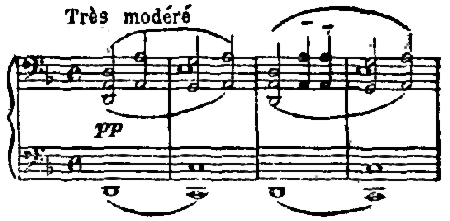
This is immediately followed by one of the most important themes in the opera, that which seems to typify the veiled and overshadowing destiny which is very close to the central thought of Maeterlinck's play. Strangely harmonized, this Fate theme (it is in the second measure that its kernel is contained, and it is this portion of it that is most frequently repeated) is sounded, pp, très modéré, by oboes, English horn, and clarinets (page 1, measure 5):

These two themes are repeated, with altered harmonization; then follows one of the two principal themes of the score—that of Mélisande, sung, doux et expressif, by the oboe over tremolos in the divided strings (page 1, measure 14):

It is followed by a derivative theme which, in the drama, suggests the naïveté of Mélisande's personality (page 1, measure 1):

Flute, oboe and clarinet repeat it over a counterpoint formed by the Fate theme (2 horns), and the curtain opens to the accompaniment of the Forest motive. This latter theme, with the motive of Fate, underscores the earlier portions of the dialogue between Golaud and Mélisande. At Golaud's words: "Oh! you are beautiful!" we hear (page 7, measure 1) an ardent phrase in the strings expressive of his awakened passion for the distressful little princess:
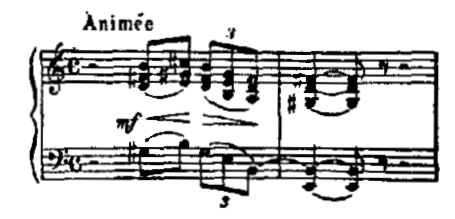
This theme is sounded again, with peculiarly penetrating effect, in the divided strings, as Golaud entreats Mélisande not "to weep so" (page 9, measure 4), and, later in the scene (page 19, measure 1), when he tells her that she must not stay in the forest alone after nightfall, and urges her to go with him. As he informs her that he is "Prince Golaud, grandson of Arkël, the aged king of Allemonde," we hear, on the bassoons and horns, his own motive (page 14, measure 8):
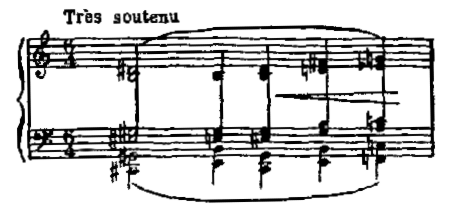
"You look like a mere child," he says, and the Mélisande theme is given out, doux et calme, by the divided strings (page 18, measure 2). As the two go out together, the motive of Fate is quietly intoned by the horns (page 22, measure 3).
An interlude of some fifty measures, in which the Forest, Fate, and Mélisande themes are exploited, introduces the second scene of the act. To an accompaniment of long-sustained chords varied by recurrences of the Mélisande theme, Geneviève reads to the venerable Arkël Golaud's letter to his brother. The entrance of Pelléas is accompanied by the theme which characterizes him throughout—the second of the two motives (that of Mélisande being the other) which most conspicuously dominate the score. It is announced (page 33, measure 10) by three flutes and a clarinet, over a viola accompaniment:
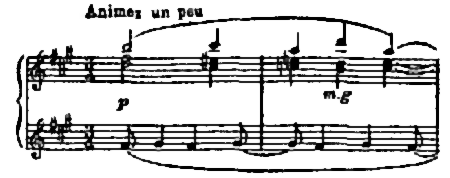
The scene closes with a variant of this, and there is an interlude in which the orchestra weaves a commentary out of the themes of Fate and Golaud's Love.
As the third scene opens (before the castle), the Mélisande theme is sung, mélancolique et doux, by the oboe against a murmuring accompaniment of the strings. Together with the Pelléas theme, it accompanies the opening portion of the scene. A suggestive use is made of a fragment of the Fate theme at Mélisande's words, after Pelléas prophesies the approach of a storm: "And yet it is so calm now!" (page 44, measure 5). Just before the voices of the departing sailors are heard, the curious student will note a characteristic passage in the orchestra (page 45, measure 1)—a sequence of descending "ninth-chords" built on a downward scale of whole tones. The Fate theme, combined with that of Mélisande, colors the rest of the scene to the end. The conclusion of the act is striking: two flutes outline a variant of the Mélisande motive; a horn sounds the first three notes of the second measure of the Fate theme, and four horns and flute sustain, pp, an unresolved suspension—C#-F#-A#-D#-G#.
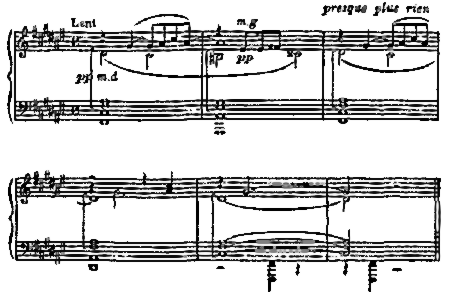
The Pelléas theme, sung by two flutes, opens the brief introduction to the second act. It is repeated, interwoven with harp arpeggios. Immediately preceding the entrance of Pelléas and Mélisande a muted horn, two flutes, two oboes, and harp sound a chord of singularly liquid quality—one of those fragmentary effects in the invention of which Debussy is so curiously happy. It is the motive of The Fountain.[8]
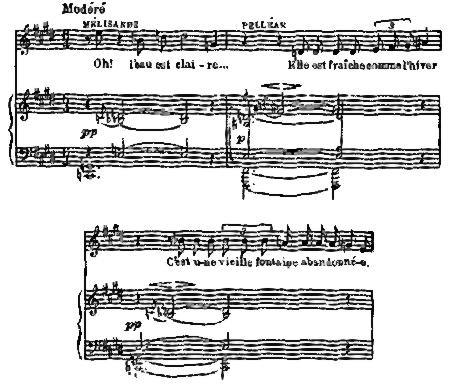
It is repeated, with still more magical effect (scored for divided violins and violas, two muted horns, and harp), as Mélisande remarks upon the clearness of the water, while the violins and violas weave about it a shimmering figure in sixteenth-notes with which its appearances are usually associated. As Pelléas warns Mélisande to take care, while she leans above the water along the marble edge of the basin, the clarinet, over a string accompaniment, announces an impassioned phrase (page 62, measure 3)—the theme of Awakening Desire:

As Pelléas questions Mélisande about the ring with which she is playing,—her wedding-ring,—and when it falls into the water while she is tossing it in the air, we hear persistently the theme of Fate, which, with the Golaud theme (portentously sounded, pp, by horns and bassoons), closes the scene. There is an interlude in which the Golaud, Mélisande, and Fate themes are heard.
The rhythm of the latter theme mutters ominously in the bass as the second scene is disclosed. When Golaud, lying wounded on his bed, describes to Mélisande how, "at the stroke of noon," his horse "swerved suddenly, with no apparent cause," and threw him, as he was hunting in the forest ("could he have seen something extraordinary?"), the oboe recalls the theme of Awakening Desire, which was first heard as Mélisande and Pelléas sat together by the fountain in the forest during the heat of midday. The rhythm of the Fate motive is hinted by violas, 'cellos, and horns as Golaud, in answer to Mélisande's compassionate questioning, observes that he is "made of iron and blood." Mélisande weeps, and the oboe sounds a plaintive variant of her motive (page 82, measure 2); the strings repeat it as she complains that she is ill. Nothing has happened, no one has harmed her, she answers, in response to Golaud's questionings: "It is no one. You do not understand me. It is something stronger than I," she says; and we hear the Pelléas theme, dulcetly harmonized, in the strings. When, later, Golaud mentions his brother's name inquiringly, and she replies that she thinks he dislikes her, although he speaks to her sometimes, we hear, very softly, the theme of Awakening Desire. As their talk progresses to its climax, there is a recurrence of the Fate theme; then, as Golaud, upon discovering the loss of her wedding-ring, harshly tells her that he "would rather have lost everything than that," the trombones and tuba declaim (page 99, measure 5) a threatening and sinister phrase which will later be more definitely associated with the thought of Golaud's vengeful purpose:
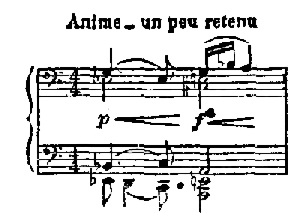
This is repeated still more vehemently three measures further on, and there is a return of the Fate motive as Mélisande, at the bidding of Golaud, goes forth to seek the missing ring. An interlude, in which are blended the variant of the Mélisande theme, which denotes her grieving, and the shimmering figure in sixteenth-notes heard during the dialogue at the fountain, leads into the scene before the grotto.
As Pelléas and Mélisande stand in the darkness of the cavern we hear again (page 110, measure 2) the variant of the Fate motive which marked the close of the preceding scene; then, as a sudden shaft of moonlight illuminates the grotto, it is expanded and transmuted into a gleaming flood of orchestral and harmonic color (two flutes, oboe, two harps glissando, string tremolos, cymbals pp). While they talk of the beggars sleeping in a corner of the cave, an oboe and flute trace a tenuous and melancholy phrase (doux et triste) which continues almost to the end of the scene; it leads into a quiet coda formed out of the theme of Fate.
After several bars of preluding by flute, harp, violas, and 'cellos (harmonics), on an arpeggio figure, ppp, flutes and oboe present (page 115, measure 6) a theme which, in an ampler version, dominates the entire scene. Its complete form, in which I conceive it to be suggestive of the magic of night, is as follows (page 118, measure 2):
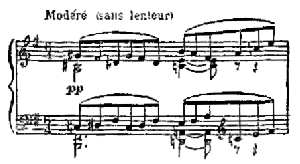
It continues in the orchestra until, as Pelléas urges Mélisande to lean further out of the window that he may see her hair unbound, a new theme enters, seeming to characterize the ardor of Pelléas' mood (page 120, measure 3[9]):
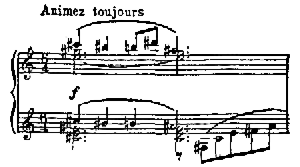
As Mélisande leans further and further out of her window, these two themes (Night and Ardor) grow increasingly insistent. They are interrupted at Pelléas' words, "I see only the branches of the willow drooping over the wall," by a rich passage for divided violins, violas, and 'cellos (page 124, measure 3), and by a brief phrase to which attention should be drawn because of its essentially Debussy-like quality—the progression in the first measure of page 125 (scored for violins and violas). Then suddenly Mélisande's unloosed hair streams down from the open window and envelops Pelléas, and we hear (a famous passage) in the strings alone, ff, a precipitate descending series of seventh-chords built on the familiar whole-tone scale which Debussy finds so impelling (page 127, measure 1).
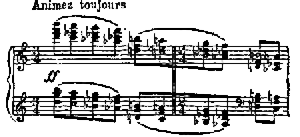
Then begins (page 128, measure 1) a delectable episode. Over a murmurous accompanying figure given out by violas, 'cellos, harp, and horn, a clarinet sings a variant of the Mélisande theme. The harmonic changes are kaleidoscopic, the orchestral color of prismatic variety. The lovely rhapsody over his belovèd's

tresses which Maeterlinck puts into the mouth of Pelléas is exquisitely enforced by the music. There is ravishing tenderness and beauty here, and an intensity of expression as penetrating as it is restrained. As Mélisande's doves come from the tower and fly about the heads of the lovers, we hear, tremolo in the strings, a variation of her motive. Golaud enters by the winding stair, and the threatening phrase quoted as Ex. XI is heard sombrely in the horns, bassoons, violas, and 'cellos—its derivation from Golaud's own theme (see Ex. VI) is here apparent. The latter motive sounds, p, as he warns Mélisande that she will fall from the window if she leans so far out. It is followed by the Fate theme as he departs, laughing nervously. A short interlude is evolved from the Mélisande theme (the Pelléas motive forming a counterpoint), and the Fate and Vengeance motives—the latter outlined, over a roll of the timpani and a sustained chord in the horns and wood-wind, by a muted trumpet, pp.
No new thematic matter is presented during the two succeeding scenes (in the vaults under the castle and, afterward, on the terrace), nor are there significant reminiscences of themes already brought forward. The music of the vault scene forms a pointed commentary on the implications of the action and dialogue—in character it is dark-hued, forbidding, sinister. As Golaud and Pelléas emerge from the vaults, much use is made in the orchestra of a jubilant figure in triplets (first given out fortissimo by flutes and oboes, over an undulating accompaniment, on page 152, measure 1) which seems to express a certain irresponsible exuberance on the part of Pelléas; it accompanies his light-hearted remarks about the odor of the flowers, the sheen of the water, and the invigorating air, as they come out upon the sunlit terrace. As the scene changes again, a very short interlude introduces a new theme—that of Little Yniold, Golaud's son, whom he is to use as the innocent tool of his suspicions. This motive, which occurs repeatedly during the ensuing scene, is one of the less important, but most typical and haunting ones, in the entire score. It is first presented (page 158, measure 4) by the oboe, doux et expressif:
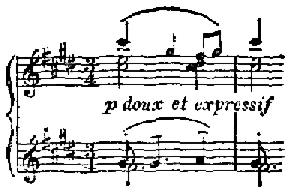
It is heard again as an accompaniment to Yniold's naïve answers to Golaud's interrogations (page 160); when he cries out that his father, in his agitation, has hurt him (page 164); and, in a particularly touching form, on page 165, measure 4, when Golaud promises that he will give him a present on the morrow if Yniold will tell him what he knows concerning Mélisande and Pelléas. We hear the Pelléas theme in the strings and wood-wind (page 172, measure 7) when Yniold says that they "weep always in the dark," and that "that makes one weep also," and again when he tells of having seen them kiss one day—"when it rained." Thereafter it is heard repeatedly in varying forms to the end of the scene, at times underlying a persistent triplet-figure which has the effect of an inverted pedal-point. A tumultuous and agitated crescendo passage brings the act to a portentous close.
A variant of the Pelléas theme, with the opening notes of the Fate motive as an under voice, begins the short prelude to the fourth act; there is a hint of the Yniold theme, and the first two notes of the Pelléas motive introduce the first scene. The interview between Mélisande and her lover, in which they arrange their tryst at the fountain in the park, is treated with restraint; an expressive phrase sung by the 'cellos (page 194, measure 11) may be noted at the point where Pelléas informs Mélisande that she will look in vain for his return after he has gone. The Mélisande theme, in a new form, opens the moving scene between Mélisande and Arkël in which he tells her of his compassionate observation of her since first she came to the castle. During his speech and her replies we hear her motive and that of Fate (page 205), the latter theme announcing the entrance of Golaud, distraught, blood-bespattered, seeking, he says, his sword. The music of the ensuing scene does not call for extended description—rather for the single comment that in it Debussy has proved once for all his power of forceful, direct, and tangible dramatic utterance: the music here, to apply to it Golaud's phrase in the play, is compact of "blood and iron"—as well it needed to be for the accentuation of this perturbing and violent episode. The Fate motive courses ominously through its earlier portions. We hear, too, what I have called the "second" Mélisande theme—that which seems to denote her naïveté (see Ex. IV), and a strange variant of the first Mélisande theme (page 212, measure 4). At the climax of the scene, when Golaud seizes his wife by her long hair and flings her from side to side, the music is as brutal, as "virile," as the most exigent could reasonably demand. Later, as he hints at his purpose,—"I shall await my chance,"—the trombones, tubas, and double-basses pizzicato mutter, pp, the motive of Vengeance. The orchestral interlude is long and elaborate. We hear a variant of the Fate theme, which reaches a climax in a fortissimo outburst of the full orchestra. The theme in this form is developed at length; there is a reminiscence of the Mélisande theme, and the music, by a gradual diminuendo, passes into the third scene of the act—in the park, before the Fountain of the Blind. At the beginning occurs the incident of the passing flock of sheep observed by Yniold. This scene need not detain us long, since it is musically as well as dramatically episodic. There are no new themes, and no significant recurrences of familiar ones, though the music is rich in suggestive and imaginative details; as I have previously noted, it is omitted in the performances at the Opéra-Comique.
Pelléas enters, and there is an impassioned declaration of his theme, scored, f, for wood-wind, horns, and strings, as he observes that he is about to depart, "crying out for joy and woe like a blind man fleeing from his burning house." There is a return of the Mélisande theme; and then, as she herself enters, and Pelléas urges her not to stay at the edge of the moonlight, but to come with him into the shadow of the linden, there enters a theme of great beauty and tenderness, announced, mystérieusement, by horns and 'cellos (page 236, measure 6). I may call it, for want of a better name, the motive of The Shadows, since it appears only in association with the thought of sheltering darkness and concealment:
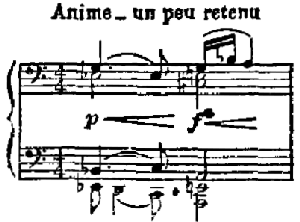
We hear the Fate motive when Mélisande warns Pelléas that it is late, that they must take care, as the gates of the castle will soon be closed for the night. There is a gracious variant of this motive as Mélisande tells how she caught her gown on the nails of the gate as she left the castle, and so was delayed. Then comes a reminiscence of the Fountain theme (the authentic wonder of which is that it is not a theme at all, but merely a single chord introduced by a grace-note; yet the vividness of its effect is indisputable), suggested, pp, by horns and harp, at Mélisande's words: "We have been here before." As Pelléas asks her if she knows why he has bidden her to meet him, strings and horn give out, pp et très expressif, a lovely phrase derived from the Pelléas theme (page 242, measure 1). Their mutual
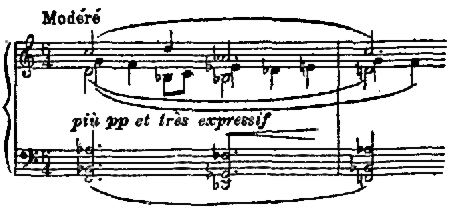
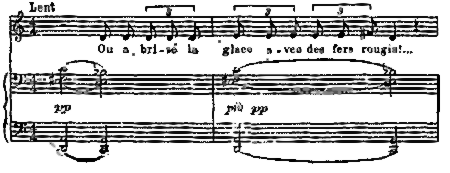
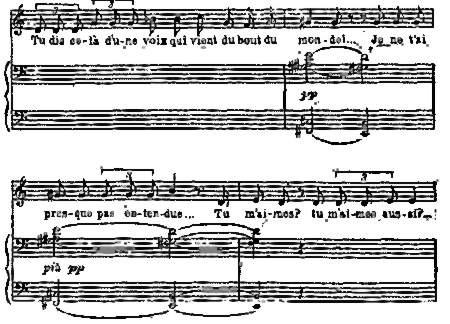

The 'cellos intone the Mélisande theme as Pelléas tells her that he has never seen anyone so beautiful as she; the theme of Ecstasy follows in the strings, horns, and wood-wind, forte; the theme of The Shadows returns as Pelléas again invites her into the darkness beneath the trees; there is a dolorous hint of the Mélisande theme as she says that she is happy, yet sad. And then the amorous and caressing quality of the music is sharply altered. There is a harsh and sinister muttering in the double-basses as Pelléas, startled by a distant sound, cries that they are closing the gates of the castle, and that they are shut out. The Golaud motive is recalled with sombre force in the strings as the rattle of the great chains is heard. "All the better! All the better!" cries Mélisande; and, as they embrace in sudden abandonment, we hear, introduced by an exquisite interplay of tonalities, the motive of Rapture, announced, pp, by divided strings and flutes (page 258, measure 12):
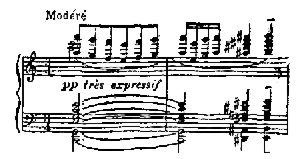
As Mélisande whispers suddenly to Pelléas that there is some one behind them, a menacing version of the Vengeance theme is played, pp, by the basses, trombones, and timpani. This theme and that of Rapture hasten the music toward its culminating point of intensity. The Pelléas theme is given out by the 'cellos, the Mélisande theme (this is not indicated in the piano version) by the violins, and as the lovers embrace desperately, a crescendo leads to a fortissimo proclamation, by all the orchestral forces, of a greatly broadened version of the motive of Ecstasy. As Golaud rushes upon them and strikes down Pelléas, the Fate theme is declaimed by four horns in unison over string tremolos; and, as he turns and silently pursues the fleeing Mélisande through the forest, his Vengeance theme brings the act, by a rapid crescendo, to a crashing close.
The last act opens with a dolorous phrase derived from the variant of the Mélisande theme noted on page 82 of the piano score. It is played by the violas, with harp accompaniment. The violins repeat it, and two flutes announce a new theme (page 268, measure 5), the motive of Pity:
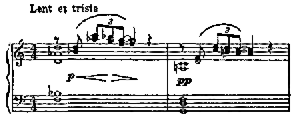
As Golaud bends with Arkël over the unconscious figure of Mélisande where she lies stretched upon her bed, muted horns and 'cellos play a gentle variant of the Fate theme, followed by the Mélisande motive as Golaud exclaims that they had but "kissed like little children." The theme of Pity accompanies Mélisande's awakening, and a new motive is heard as she responds, to Arkël's question: "I have never been better." This new theme (page 274, measure 4), of extraordinary poignancy, is given out by an oboe supported by two flutes, and its expression is marked triste et très doucement expressif. I shall call it the motive of Sorrow, for it seems like the comment of the music upon the transporting and utter sadness of the play's dénouement. It voices a gentle and passive commiseration, rather than a profound and shaking grief:
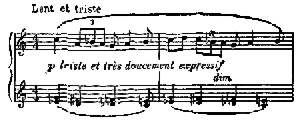
A third new theme, also of searching pathos, occurs in the strings, p, très doux, as Mélisande quietly greets her husband (page 279, measure 1), and later, when she says that she forgives him (page 282, measure 1). It may be called the motive of Mélisande's Gentleness:
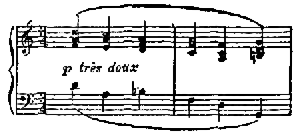
As Golaud's still unvanquished doubts and suspicions torture him into harsh interrogations, and he asks her if she loved Pelléas "with a forbidden love," an oboe and two flutes recall, p et doux, the Rapture motive. Later, in succession, we hear (on a solo violin over flute and clarinets) the Pelléas theme (page 289, measure 2), the motive of Gentleness, for the last time (page 290, measure 3), and the Mélisande theme (pages 290-292). As Mélisande recognizes Arkël, and asks if it be true "that the winter is coming," a solo violin, solo 'cello, and two clarinets play an affecting phrase (page 294, measure 5). She tells Arkël that she does not wish the windows closed until the sun has sunk into the sea, and the orchestra accompanies her in a passage of curiously delicate sonority (page 295, measure 6).
The final scene of the act is treated with surpassing reticence, dignity, and simplicity, yet with piercing intensity of expression. Nothing could be at the same time more sparing of means and more exquisitely eloquent in result than Debussy's setting of the scene of Mélisande's death—it is music which dims the eyes and subdues the spirit. The pianissimo-repeated chords in the divided strings which accentuate Arkël's warning words (page 304, measure 8); the blended tones of the harp and the distant bell at the moment of dissolution (page 306, measure 11); Arkël's simple requiem over the body of the little princess, with the grave and tender orchestral commentary woven out of familiarly poignant themes (pages 308-309); the murmurous coda, with its muted trumpet singing a gentle dirge under an accompaniment of two flutes (page 310, measure 7),—these things are easy to
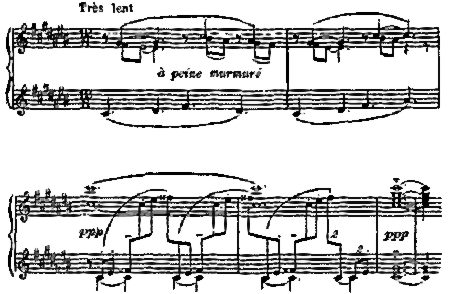
Concerning felicities of structural and technical detail in the work as a whole, this has not been the place to speak; but if curious appreciators, or others who are merely curious, should perhaps be induced, by what has been written here, to explore for themselves Debussy's beautiful and in many ways incomparable score, the purpose of this study will have been achieved.
[1] He no longer uses the first of these given names.
[2] A revised version of these songs was published fifteen years later, in 1903, dedicated à Miss Mary Garden, inoubliable Mélisande.
[3] M. Debussy sends me the information that, although the music of Pelléas et Mélisande was begun as early as September, 1893, he was not finally through with it until nine years later. In the spring of 1901 the last scene of the fourth act (the love-scene at the fountain in the park, with its abrupt and tragic close) was rewritten, and in 1902, after the first rehearsals at the Opéra-Comique, it was found necessary to lengthen the orchestral interludes between the different tableaux in order that the scene-shifters might have sufficient time to change the settings. These extended interludes are included in the edition of the score for piano and voices, with French and English text, published in 1907.
[4] The above is written in July, 1907.
[5] Although this scene was set to music by Debussy, and appears in both the orchestral and piano scores, it is omitted from the performances at the Opéra-Comique.
[6] Its curious progressions, based on the Dorian mode of the plain-chant (corresponding to a scale of D-minor without accidentals), I have alluded to in a previous chapter.
[7] These indications refer to the arrangement of the score for voices and piano, with French and English text, published by A. Durand & Fils of Paris in 1907. I have indicated in each case, in addition to the page, the measure in which the example begins.
[8] I quote it in the completer and more beautiful form in which it appears on page 57, measures 1-3.
[9] I quote it as it appears in its maturer form on page 125 (measure 3).
End of Project Gutenberg's Debussy's Pelléas et Mélisande, by Lawrence Gilman
*** END OF THIS PROJECT GUTENBERG EBOOK DEBUSSY'S PELLÉAS ET MÉLISANDE ***
***** This file should be named 16488-h.htm or 16488-h.zip *****
This and all associated files of various formats will be found in:
https://www.gutenberg.org/1/6/4/8/16488/
Produced by David Newman, Chuck Greif and the Online
Distributed Proofreading Team at https://www.pgdp.net
Updated editions will replace the previous one--the old editions
will be renamed.
Creating the works from public domain print editions means that no
one owns a United States copyright in these works, so the Foundation
(and you!) can copy and distribute it in the United States without
permission and without paying copyright royalties. Special rules,
set forth in the General Terms of Use part of this license, apply to
copying and distributing Project Gutenberg-tm electronic works to
protect the PROJECT GUTENBERG-tm concept and trademark. Project
Gutenberg is a registered trademark, and may not be used if you
charge for the eBooks, unless you receive specific permission. If you
do not charge anything for copies of this eBook, complying with the
rules is very easy. You may use this eBook for nearly any purpose
such as creation of derivative works, reports, performances and
research. They may be modified and printed and given away--you may do
practically ANYTHING with public domain eBooks. Redistribution is
subject to the trademark license, especially commercial
redistribution.
*** START: FULL LICENSE ***
THE FULL PROJECT GUTENBERG LICENSE
PLEASE READ THIS BEFORE YOU DISTRIBUTE OR USE THIS WORK
To protect the Project Gutenberg-tm mission of promoting the free
distribution of electronic works, by using or distributing this work
(or any other work associated in any way with the phrase "Project
Gutenberg"), you agree to comply with all the terms of the Full Project
Gutenberg-tm License (available with this file or online at
https://gutenberg.org/license).
Section 1. General Terms of Use and Redistributing Project Gutenberg-tm
electronic works
1.A. By reading or using any part of this Project Gutenberg-tm
electronic work, you indicate that you have read, understand, agree to
and accept all the terms of this license and intellectual property
(trademark/copyright) agreement. If you do not agree to abide by all
the terms of this agreement, you must cease using and return or destroy
all copies of Project Gutenberg-tm electronic works in your possession.
If you paid a fee for obtaining a copy of or access to a Project
Gutenberg-tm electronic work and you do not agree to be bound by the
terms of this agreement, you may obtain a refund from the person or
entity to whom you paid the fee as set forth in paragraph 1.E.8.
1.B. "Project Gutenberg" is a registered trademark. It may only be
used on or associated in any way with an electronic work by people who
agree to be bound by the terms of this agreement. There are a few
things that you can do with most Project Gutenberg-tm electronic works
even without complying with the full terms of this agreement. See
paragraph 1.C below. There are a lot of things you can do with Project
Gutenberg-tm electronic works if you follow the terms of this agreement
and help preserve free future access to Project Gutenberg-tm electronic
works. See paragraph 1.E below.
1.C. The Project Gutenberg Literary Archive Foundation ("the Foundation"
or PGLAF), owns a compilation copyright in the collection of Project
Gutenberg-tm electronic works. Nearly all the individual works in the
collection are in the public domain in the United States. If an
individual work is in the public domain in the United States and you are
located in the United States, we do not claim a right to prevent you from
copying, distributing, performing, displaying or creating derivative
works based on the work as long as all references to Project Gutenberg
are removed. Of course, we hope that you will support the Project
Gutenberg-tm mission of promoting free access to electronic works by
freely sharing Project Gutenberg-tm works in compliance with the terms of
this agreement for keeping the Project Gutenberg-tm name associated with
the work. You can easily comply with the terms of this agreement by
keeping this work in the same format with its attached full Project
Gutenberg-tm License when you share it without charge with others.
1.D. The copyright laws of the place where you are located also govern
what you can do with this work. Copyright laws in most countries are in
a constant state of change. If you are outside the United States, check
the laws of your country in addition to the terms of this agreement
before downloading, copying, displaying, performing, distributing or
creating derivative works based on this work or any other Project
Gutenberg-tm work. The Foundation makes no representations concerning
the copyright status of any work in any country outside the United
States.
1.E. Unless you have removed all references to Project Gutenberg:
1.E.1. The following sentence, with active links to, or other immediate
access to, the full Project Gutenberg-tm License must appear prominently
whenever any copy of a Project Gutenberg-tm work (any work on which the
phrase "Project Gutenberg" appears, or with which the phrase "Project
Gutenberg" is associated) is accessed, displayed, performed, viewed,
copied or distributed:
This eBook is for the use of anyone anywhere at no cost and with
almost no restrictions whatsoever. You may copy it, give it away or
re-use it under the terms of the Project Gutenberg License included
with this eBook or online at www.gutenberg.org
1.E.2. If an individual Project Gutenberg-tm electronic work is derived
from the public domain (does not contain a notice indicating that it is
posted with permission of the copyright holder), the work can be copied
and distributed to anyone in the United States without paying any fees
or charges. If you are redistributing or providing access to a work
with the phrase "Project Gutenberg" associated with or appearing on the
work, you must comply either with the requirements of paragraphs 1.E.1
through 1.E.7 or obtain permission for the use of the work and the
Project Gutenberg-tm trademark as set forth in paragraphs 1.E.8 or
1.E.9.
1.E.3. If an individual Project Gutenberg-tm electronic work is posted
with the permission of the copyright holder, your use and distribution
must comply with both paragraphs 1.E.1 through 1.E.7 and any additional
terms imposed by the copyright holder. Additional terms will be linked
to the Project Gutenberg-tm License for all works posted with the
permission of the copyright holder found at the beginning of this work.
1.E.4. Do not unlink or detach or remove the full Project Gutenberg-tm
License terms from this work, or any files containing a part of this
work or any other work associated with Project Gutenberg-tm.
1.E.5. Do not copy, display, perform, distribute or redistribute this
electronic work, or any part of this electronic work, without
prominently displaying the sentence set forth in paragraph 1.E.1 with
active links or immediate access to the full terms of the Project
Gutenberg-tm License.
1.E.6. You may convert to and distribute this work in any binary,
compressed, marked up, nonproprietary or proprietary form, including any
word processing or hypertext form. However, if you provide access to or
distribute copies of a Project Gutenberg-tm work in a format other than
"Plain Vanilla ASCII" or other format used in the official version
posted on the official Project Gutenberg-tm web site (www.gutenberg.org),
you must, at no additional cost, fee or expense to the user, provide a
copy, a means of exporting a copy, or a means of obtaining a copy upon
request, of the work in its original "Plain Vanilla ASCII" or other
form. Any alternate format must include the full Project Gutenberg-tm
License as specified in paragraph 1.E.1.
1.E.7. Do not charge a fee for access to, viewing, displaying,
performing, copying or distributing any Project Gutenberg-tm works
unless you comply with paragraph 1.E.8 or 1.E.9.
1.E.8. You may charge a reasonable fee for copies of or providing
access to or distributing Project Gutenberg-tm electronic works provided
that
- You pay a royalty fee of 20% of the gross profits you derive from
the use of Project Gutenberg-tm works calculated using the method
you already use to calculate your applicable taxes. The fee is
owed to the owner of the Project Gutenberg-tm trademark, but he
has agreed to donate royalties under this paragraph to the
Project Gutenberg Literary Archive Foundation. Royalty payments
must be paid within 60 days following each date on which you
prepare (or are legally required to prepare) your periodic tax
returns. Royalty payments should be clearly marked as such and
sent to the Project Gutenberg Literary Archive Foundation at the
address specified in Section 4, "Information about donations to
the Project Gutenberg Literary Archive Foundation."
- You provide a full refund of any money paid by a user who notifies
you in writing (or by e-mail) within 30 days of receipt that s/he
does not agree to the terms of the full Project Gutenberg-tm
License. You must require such a user to return or
destroy all copies of the works possessed in a physical medium
and discontinue all use of and all access to other copies of
Project Gutenberg-tm works.
- You provide, in accordance with paragraph 1.F.3, a full refund of any
money paid for a work or a replacement copy, if a defect in the
electronic work is discovered and reported to you within 90 days
of receipt of the work.
- You comply with all other terms of this agreement for free
distribution of Project Gutenberg-tm works.
1.E.9. If you wish to charge a fee or distribute a Project Gutenberg-tm
electronic work or group of works on different terms than are set
forth in this agreement, you must obtain permission in writing from
both the Project Gutenberg Literary Archive Foundation and Michael
Hart, the owner of the Project Gutenberg-tm trademark. Contact the
Foundation as set forth in Section 3 below.
1.F.
1.F.1. Project Gutenberg volunteers and employees expend considerable
effort to identify, do copyright research on, transcribe and proofread
public domain works in creating the Project Gutenberg-tm
collection. Despite these efforts, Project Gutenberg-tm electronic
works, and the medium on which they may be stored, may contain
"Defects," such as, but not limited to, incomplete, inaccurate or
corrupt data, transcription errors, a copyright or other intellectual
property infringement, a defective or damaged disk or other medium, a
computer virus, or computer codes that damage or cannot be read by
your equipment.
1.F.2. LIMITED WARRANTY, DISCLAIMER OF DAMAGES - Except for the "Right
of Replacement or Refund" described in paragraph 1.F.3, the Project
Gutenberg Literary Archive Foundation, the owner of the Project
Gutenberg-tm trademark, and any other party distributing a Project
Gutenberg-tm electronic work under this agreement, disclaim all
liability to you for damages, costs and expenses, including legal
fees. YOU AGREE THAT YOU HAVE NO REMEDIES FOR NEGLIGENCE, STRICT
LIABILITY, BREACH OF WARRANTY OR BREACH OF CONTRACT EXCEPT THOSE
PROVIDED IN PARAGRAPH F3. YOU AGREE THAT THE FOUNDATION, THE
TRADEMARK OWNER, AND ANY DISTRIBUTOR UNDER THIS AGREEMENT WILL NOT BE
LIABLE TO YOU FOR ACTUAL, DIRECT, INDIRECT, CONSEQUENTIAL, PUNITIVE OR
INCIDENTAL DAMAGES EVEN IF YOU GIVE NOTICE OF THE POSSIBILITY OF SUCH
DAMAGE.
1.F.3. LIMITED RIGHT OF REPLACEMENT OR REFUND - If you discover a
defect in this electronic work within 90 days of receiving it, you can
receive a refund of the money (if any) you paid for it by sending a
written explanation to the person you received the work from. If you
received the work on a physical medium, you must return the medium with
your written explanation. The person or entity that provided you with
the defective work may elect to provide a replacement copy in lieu of a
refund. If you received the work electronically, the person or entity
providing it to you may choose to give you a second opportunity to
receive the work electronically in lieu of a refund. If the second copy
is also defective, you may demand a refund in writing without further
opportunities to fix the problem.
1.F.4. Except for the limited right of replacement or refund set forth
in paragraph 1.F.3, this work is provided to you 'AS-IS', WITH NO OTHER
WARRANTIES OF ANY KIND, EXPRESS OR IMPLIED, INCLUDING BUT NOT LIMITED TO
WARRANTIES OF MERCHANTIBILITY OR FITNESS FOR ANY PURPOSE.
1.F.5. Some states do not allow disclaimers of certain implied
warranties or the exclusion or limitation of certain types of damages.
If any disclaimer or limitation set forth in this agreement violates the
law of the state applicable to this agreement, the agreement shall be
interpreted to make the maximum disclaimer or limitation permitted by
the applicable state law. The invalidity or unenforceability of any
provision of this agreement shall not void the remaining provisions.
1.F.6. INDEMNITY - You agree to indemnify and hold the Foundation, the
trademark owner, any agent or employee of the Foundation, anyone
providing copies of Project Gutenberg-tm electronic works in accordance
with this agreement, and any volunteers associated with the production,
promotion and distribution of Project Gutenberg-tm electronic works,
harmless from all liability, costs and expenses, including legal fees,
that arise directly or indirectly from any of the following which you do
or cause to occur: (a) distribution of this or any Project Gutenberg-tm
work, (b) alteration, modification, or additions or deletions to any
Project Gutenberg-tm work, and (c) any Defect you cause.
Section 2. Information about the Mission of Project Gutenberg-tm
Project Gutenberg-tm is synonymous with the free distribution of
electronic works in formats readable by the widest variety of computers
including obsolete, old, middle-aged and new computers. It exists
because of the efforts of hundreds of volunteers and donations from
people in all walks of life.
Volunteers and financial support to provide volunteers with the
assistance they need, is critical to reaching Project Gutenberg-tm's
goals and ensuring that the Project Gutenberg-tm collection will
remain freely available for generations to come. In 2001, the Project
Gutenberg Literary Archive Foundation was created to provide a secure
and permanent future for Project Gutenberg-tm and future generations.
To learn more about the Project Gutenberg Literary Archive Foundation
and how your efforts and donations can help, see Sections 3 and 4
and the Foundation web page at https://www.pglaf.org.
Section 3. Information about the Project Gutenberg Literary Archive
Foundation
The Project Gutenberg Literary Archive Foundation is a non profit
501(c)(3) educational corporation organized under the laws of the
state of Mississippi and granted tax exempt status by the Internal
Revenue Service. The Foundation's EIN or federal tax identification
number is 64-6221541. Its 501(c)(3) letter is posted at
https://pglaf.org/fundraising. Contributions to the Project Gutenberg
Literary Archive Foundation are tax deductible to the full extent
permitted by U.S. federal laws and your state's laws.
The Foundation's principal office is located at 4557 Melan Dr. S.
Fairbanks, AK, 99712., but its volunteers and employees are scattered
throughout numerous locations. Its business office is located at
809 North 1500 West, Salt Lake City, UT 84116, (801) 596-1887, email
business@pglaf.org. Email contact links and up to date contact
information can be found at the Foundation's web site and official
page at https://pglaf.org
For additional contact information:
Dr. Gregory B. Newby
Chief Executive and Director
gbnewby@pglaf.org
Section 4. Information about Donations to the Project Gutenberg
Literary Archive Foundation
Project Gutenberg-tm depends upon and cannot survive without wide
spread public support and donations to carry out its mission of
increasing the number of public domain and licensed works that can be
freely distributed in machine readable form accessible by the widest
array of equipment including outdated equipment. Many small donations
($1 to $5,000) are particularly important to maintaining tax exempt
status with the IRS.
The Foundation is committed to complying with the laws regulating
charities and charitable donations in all 50 states of the United
States. Compliance requirements are not uniform and it takes a
considerable effort, much paperwork and many fees to meet and keep up
with these requirements. We do not solicit donations in locations
where we have not received written confirmation of compliance. To
SEND DONATIONS or determine the status of compliance for any
particular state visit https://pglaf.org
While we cannot and do not solicit contributions from states where we
have not met the solicitation requirements, we know of no prohibition
against accepting unsolicited donations from donors in such states who
approach us with offers to donate.
International donations are gratefully accepted, but we cannot make
any statements concerning tax treatment of donations received from
outside the United States. U.S. laws alone swamp our small staff.
Please check the Project Gutenberg Web pages for current donation
methods and addresses. Donations are accepted in a number of other
ways including including checks, online payments and credit card
donations. To donate, please visit: https://pglaf.org/donate
Section 5. General Information About Project Gutenberg-tm electronic
works.
Professor Michael S. Hart was the originator of the Project Gutenberg-tm
concept of a library of electronic works that could be freely shared
with anyone. For thirty years, he produced and distributed Project
Gutenberg-tm eBooks with only a loose network of volunteer support.
Project Gutenberg-tm eBooks are often created from several printed
editions, all of which are confirmed as Public Domain in the U.S.
unless a copyright notice is included. Thus, we do not necessarily
keep eBooks in compliance with any particular paper edition.
Most people start at our Web site which has the main PG search facility:
https://www.gutenberg.org
This Web site includes information about Project Gutenberg-tm,
including how to make donations to the Project Gutenberg Literary
Archive Foundation, how to help produce our new eBooks, and how to
subscribe to our email newsletter to hear about new eBooks.
*** END: FULL LICENSE ***